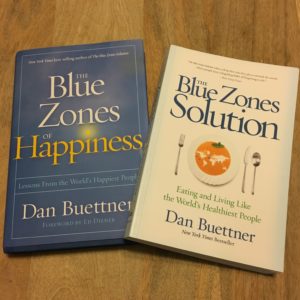Many years ago, I lived in Loma Linda, CA. I had never heard of the town until I moved there, but it was a beautiful area and I enjoyed living there. Shortly after I moved away, an article by Dan Buettner appeared in the November 2005 National Geographic describing ŌĆ£blue zones.ŌĆØ[1]
People in these blue zone areas have longer and healthier lives than the average person. I discovered his work several years later and was excited to see my former town listed. Alas, it was only the Seventh Day Adventist community in Loma Linda that made the blue zone list, so that let me out. Nevertheless, I was curious about blue zones and began reading about the topic. ┬Ā
You may have heard about some areas in Japan or Greece that have a high number of centenarians. Originally, there were five areas identified as blue zones. These days Buettner and his group have introduced blue zone characteristics to other cities in the hope of bringing about positive changes. Just what are these characteristics? Can anyone adopt them? Do we have to live in designated blue zone areas? Take a look:
- Move Naturally (walking, gardening, biking, etc.)
- Purpose (what makes your life worthwhile)
- Down Shift (use natural strategies to destress)
- 80% Rule (stop eating when youŌĆÖre 80% full)
- Plant Slant (mostly vegetarian/plant-based diet)
- Wine at 5 (moderate drinking, if health and/or faith allow)
- Belong (strong sense of community, often faith-based)
- Loved Ones First (prioritize family, including the elderly)
- Right Tribe (social circles supporting healthy behaviors)
Fast forward several years when I began listening to podcasts and reading blogs and books on minimalism. I didnŌĆÖt make the connection at first, but when I renewed my interest in blue zones, I noticed more than a few parallels to the minimalist lifestyle. The people living in these blue zones donŌĆÖt need big or fancy houses, lots of possessions, elaborate meals, or gym memberships to stay healthy and happy. Relationships with family and oneŌĆÖs social circle are important. Creating a meaningful life and finding oneŌĆÖs purpose are important. Eating and drinking moderately are important. Gee, itŌĆÖs starting to sound a lot like a minimalist lifestyle!
You may think, hold on thereŌĆöIŌĆÖm not mostly vegetarian or I donŌĆÖt drink at all or IŌĆÖm not religious. People leaning towards a minimalist or simple lifestyle come from diverse backgrounds and make a variety of choices, but then so do those living in blue zones. Most of the blue zone populations eat some fish and meat, just not much. Seventh Day Adventists donŌĆÖt drink alcohol or eat any meat. Having a strong sense of community is often faith-based for people in blue zones, but not always, and faith can be interpreted more broadly than following organized religion.
Whether our interests
lean more towards minimalism and living simply or more towards a blue zone
lifestyle, we can learn from both and take what suits us best. To paraphrase a
classic: Mid-life minimalists, I think this is the beginning of a beautiful friendship.
[1] The concept of ŌĆ£blue zonesŌĆØ began with research of Gianni Pes and Michel Poulain, who were looking at the highest concentrations of male centenarians. They drew blue circles on a map that showed areas extreme longevity.

RESOURCES
Buettner, Dan ┬ĀThe Blue Zones, Second Edition: 9 Lessons for Living Longer From the People WhoŌĆÖve Lived the Longest
The Blue Zones Solution: Eating and Living Like the WorldŌĆÖs Healthiest People
The Blue Zones of Happiness: Lessons From the WorldŌĆÖs Happiest People
National Geographic Magazine 2018, Blue Zones (REISSUE)
Blue Zones┬Ā (website)

I have read the books and started my minimalist journey a few years ago. Still working on it but the parallel makes complete sense and is encouraging. Nicely written thanks
Thanks! I think the minimalist journey is for life. Every new stage of life down to a new daily situation brings change and challenges. We have to figure out how to deal with it without losing our desire to simplify!